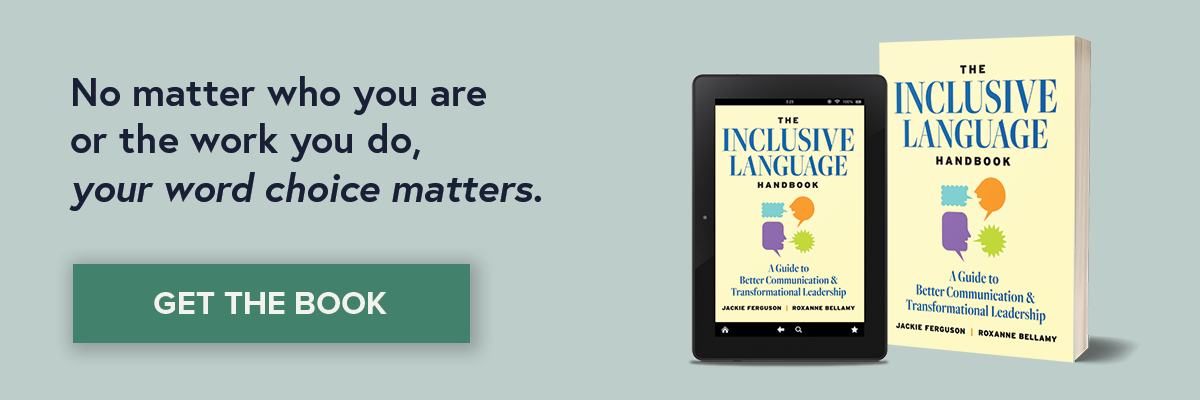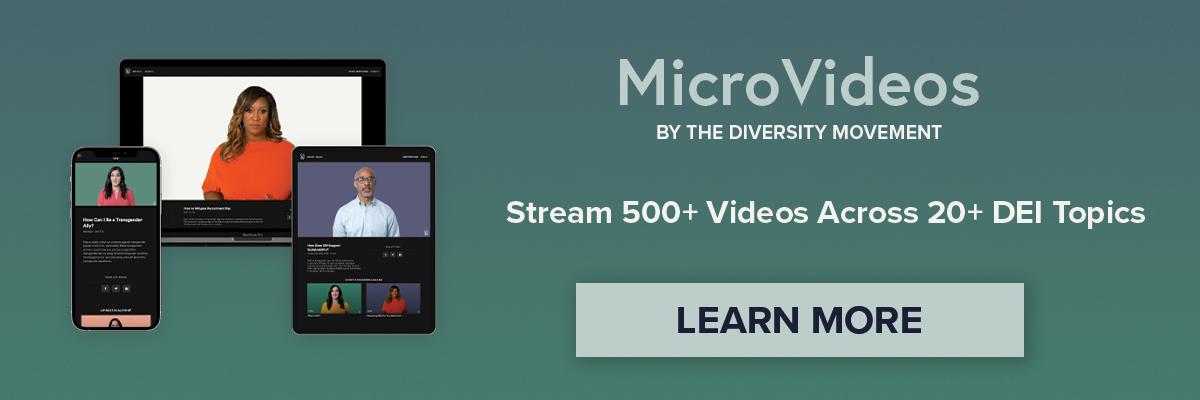Inclusive language is the practice of choosing your words mindfully in a way that shows respect for the varied experiences, backgrounds, and identities of all the people around you. As values like diversity and inclusion play an increasingly important role in decision-making for consumers, shareholders, and job seekers alike, inclusive language must become a foundational aspect of all your business communications – including your employee handbook and manuals, your marketing messaging, and the way you speak with customers and clients on a daily basis. Otherwise, you’re going to fall behind.
The best way to put inclusive language into practice varies widely by industry. My book, The Inclusive Language Handbook: A Guide to Better Communication and Transformational Leadership, co-authored with The Diversity Movement’s Head of Content and Programming, Jackie Ferguson, includes specific recommendations for inclusive language in healthcare, retail, education, government and public services, insurance, finance, manufacturing, and more. Here, I want to zoom in to focus on the tech sector specifically, with best-practice recommendations for implementing inclusive language at both the individual and organization-wide levels.
Why tech firms should care about inclusive language
Technology plays a huge and growing role in virtually all aspects of our lives. Yet, with enormous tech growth has come a new set of challenges, particularly around public perception and consumer trust. The 2018 edition of the State of Startups survey conducted by First Round Capital found that 77% of tech startup founders agreed with the statement that “tech giants like Facebook, Twitter, Amazon, and Google, are being perceived as evil for taking advantage of our deepest, darkest secrets and fears.” Meanwhile, just 54% of people in the U.S. trust tech companies to “do the right thing,” according to Edelman’s annual 2022 Trust Barometer.
The technology industry has also faced intense criticism for its lack of diverse representation at every level, and rightfully so. In 2021, men occupied more than 73% of all tech jobs, and 7 out of 10 tech workers were White. Additionally, ageism and age-related bias are widely regarded as one of the tech industry’s largest barriers to diversity and inclusion in the workplace, with older professionals often facing coded language, outright discrimination, and rampant microaggressions. It’s clear that the tech sector has a diversity and inclusion problem, and while using inclusive language may not be a complete solution, it’s certainly a step in the right direction.
In addition to these challenges regarding public trust and diverse representation, technology-centered organizations also face a host of other complicated issues that leaders must contend with on a daily basis, like heightened competition, security concerns, regulatory compliance, and finding motivated, qualified talent, to name just a few.
To effectively overcome these challenges and future-proof your organization for success in an increasingly diverse landscape of consumers and job candidates, technology firms must begin developing their inclusive language skills across the board. That means communicating in a way that’s fair, respectful, and free of bias, whether you’re communicating in-person, in job postings, or across social media platforms.
Building a foundation of inclusive language will set you up for success in developing high-trust relationships, strengthening consumer confidence, and attracting – and retaining – top talent through the years. Inclusive language is an excellent first step toward sustainable, long-term success.
Simple language changes that will increase inclusion
When you break it down to a granular level, prioritizing inclusive language in your business communications is about making smarter language choices. Let’s examine a few examples of non-inclusive language commonly used in the tech industry, and what you can say instead to be more inclusive and, ultimately, drive better business outcomes.
First, much of the existing tech lexicon centers on youthfulness and young people. Using phrases like “digital native,” “fresh,” “recent graduate,” and “energetic” in your job listings may cause workers from older generations to feel excluded and unwelcome at your company. This type of language implies that you’re looking for younger workers, and younger workers only, which can severely limit the number of qualified job applicants you attract, thereby leading to a skewed and unrepresentative workforce. The risk there is that you’re creating a team with a narrow range of experiences and perspectives, and in the process, limiting your own ability to innovate and forge ahead.
Opt instead for more inclusive language like “skilled,” “creative,” “curious,” and “collaborative.” These neutral descriptors don’t exclude people from certain age groups, but they still allow you to communicate what you’re looking for in a job candidate. Naming your values as an organization is different than naming the type of person who you think might best display those traits.
Also, confront age-related microaggressions swiftly and directly when you encounter them. Comments like “okay, boomer” and “you probably haven’t heard of this” have no place in a thriving, multigenerational, diverse workplace.
Next, insist on inclusive language for all users, paying special attention to those who have disabilities or require accommodations. Avoid the phrases “impaired” or “impairment,” which are offensive to many people because they imply damage and limitation. Instead, keep focused on the whole, complex person and the specific, relevant details that might impact their ability to interact with your product.
For instance, rather than saying “vision impaired,” for example, say “a person who uses a screen reader.” Instead of “hearing impaired,” say “a person who is Deaf or hard of hearing.” These small changes in language choice make a big impact by centering the person first, not the condition. Putting people first upholds each individual’s dignity and humanity, and is one of the most important guidelines for inclusive language.
Equip yourself with the right tools to win
Technology is a crowded and fiercely competitive industry that faces a unique set of challenges. As the tech sector continues to boom, it will likely become even harder to attract top professional talent, overcome negative public perceptions, and build long-lasting, successful relationships with stakeholders. Smart tech leaders know that one of the best ways to set yourself apart from the competition is to be intentional about the way you communicate with customers, partners, employees, and shareholders.
You can’t make inclusive language a part of your organizational identity overnight; it takes time, practice, and the right tools at your disposal. Start small by offering an inclusive language course and unconscious bias training to leadership, which will help you mitigate bias against people from different cultural backgrounds, ethnicities, religions, genders, and more. Unconscious bias exists beneath our perception, and it may be hindering your company’s ability to recruit diverse talent and engage with a broad swath of consumers. Engaging in training can help root out any unconscious biases that may be holding you back.
Also, find short and easily-digestible ways for your team to start learning about diversity, equity, and inclusion. MicroVideos from The Diversity Movement, my team’s award-winning microlearning platform, which was recently named one of Fast Company’s 2022 “World Changing Ideas” provides 500+ bite-sized videos and opportunities for learning about a wide variety of subjects from inclusive language to gender identity to disability and accessibility. The best part is, your employees can watch these videos on their own time in a matter of minutes.
For more in-depth information about inclusive language in the tech sector, I encourage you to buy the full book, The Inclusive Language Handbook: A Guide to Better Communication and Transformational Leadership, available now through all major bookstores. Too often, business leaders think diversity, equity, and inclusion needs to be an organization-wide overhaul of processes and procedures in order to be effective. But the truth is, even seemingly-small steps like learning more about inclusive language can start your organization on the right track and build momentum for bigger changes.
With an academic background in literature and linguistics, Roxanne Bellamy, CDE, loves exploring the intersection between the words we choose and the way we see the world.






